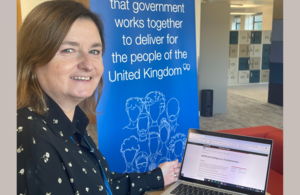How data is helping local authorities deliver better services
.jpg?width=720&name=Untitled%20design%20(13).jpg)
How is data improving the quality of local authorities' services? Five local government experts shared their experiences in a panel discussion moderated by Government Transformation’s David Wilde. Here are the key takeaways from the session.
Why an integrated approach to data is essential
For Liz St Louis, Assistant Director of Smart Cities at Sunderland City Council, an integrated approach to data is “absolutely pivotal” to support the work of the local authority and deliver services, not least during the pandemic.
“Data has been very important for us during the last couple of years to help us generate new insights, make intelligence-led and very good commissioning decisions to help us manage the huge waves of demand that we’ve seen throughout the pandemic,” St Louis said. “It has helped us ensure that our customers’ needs are met more directly and therefore reducing the call on resources, not to mention how data has really helped us to drive and deliver transformational change.”
In 2020, Sunderland was named Smart City of the Year at the Digital Leaders Awards for its innovative use of technology for the public benefit, most of which is underpinned by data. 
St Louis’s team uses data aggregation and visualisation to help delivery teams to view information about their customers. Whereas before data would be scattered across different legacy systems, now it is all located in one place: “That’s assisting our practitioners to understand the risk factors associated with individuals in the communities and take a much more targeted and appropriate action.”
By bringing together data on a geographical basis, St Louis said that the council can easily view demand for services, monitor complaints and compliments, and see where resources are based across the city.
“That supports us with setting priorities, it supports our elected members with setting priorities across our wards, and really helps us with resource planning to meet demand," she added.
An integrated data approach is also essential to the London Borough of Lambeth, said Michael Sinclair, Head of Data, Analytics and Insight at the local authority. The benefits of this approach were best appreciated during the pandemic, when having a “shared view of the customer” helped with more effective allocation of resources and smarter service delivery.
Lambeth is also using data to offer a “digital front door” to residents since it has a mission to enable everyone in the borough to engage and get the most out of digital, from being able to find jobs online to accessing services digitally.
“We're using our data to help understand and deliver non-digital services to engage with these people to help them engage digitally,” Sinclair said, adding that they are working on two fronts: improving the quality of digital services and understanding the reasons why some people are not engaging with them.
Direct and indirect benefits of data to citizens
As a strategic regional authority within local government, London’s data use cases with a direct impact on citizens are limited. However, the Greater London Authority (GLA) heavily uses data to support those who serve citizens, said Theo Blackwell, Chief Digital Officer for London.
In 2010, the GLA launched an open data-sharing platform with the initial purpose to promote civic transparency and accountability. The London Datastore, as the platform is called, can be used by anyone to access data from over 1,000 datasets and metadata relating to housing, air quality, health, street safety and other issues affecting Londoners.

Citizens are ultimately benefited by initiatives such as the London Datastore when developers use that data to create apps for public consumption.
“This will be vital for things like climate change because a crucial part of it isn’t just monitoring progress towards Net Zero, it’s about behaviour change with citizens,” Blackwell said.
Another tool, the Planning London Datahub, provides a live draw of all the planning applications across the 32 London boroughs.
“We also have projects which use data for deep innovation, such as bringing in all sorts of different datasets, from cameras and sensor feeds to more static datasets, to understand air quality and develop services from those points onwards,” Blackwell added. “Having a good infrastructure based upon data creates new opportunities, both for citizens and for industry.”
Blackwell warned, however, that having huge amounts of data in itself does not necessarily change the delivery model. It needs a strong transformation drive and a good methodology centred around the needs of the user, whether that is the end-user/citizen or another user, such a business or another stakeholder in the public sector.
Blackwell’s team is currently developing a new data-sharing platform based on the foundations of the London Datastore. It has a data service standard, similar to the Government Digital Service’s (GDS) service standard, so projects are created consistently with the same methodology and with the same data ethics standards.
“How design and data work together is really important for us and has to go hand in hand with the approach on digital transformation,” Blackwell added.
Continuing to unlock the potential of data
Kurt Frary, Chief Technology Officer at Norfolk County Council, told delegates at the LocalGov Transformation Show that data has an important impact on service delivery as it allows local authorities to help more people, sometimes for less, since it highlights where services need to be focused and targeted. 
“The more data we have, and the more we understand, the more we can change the narrative, both for our citizens and the service providers,” Frary said.
As examples of how data is improving services in Norfolk County Council, he said that a bed-blocking app is using aggregated data from various service providers to find hospital beds for those who need them.
Frary’s team is also using internet of things (IoT) for social care to enable ageing people to live independently for longer by placing sensors in kettles or other appliances that detect movement and alert carers or family members if there is unusual activity.
Technology company Microland is working with local authorities across the UK and witnessing first hand how getting to grips with the varied data sources associated with public services can create new opportunities. In healthcare, they have been using IoT sensors to identify bed occupancy in hospitals, said Karthikeyan Krishnan, the firm’s SVP for EMEA. In his view, local councils should dig into the rich amounts of data that they have to unlock opportunities for better and more inclusive public services and to tackle issues such as digital exclusion.
Krishnan added: “We should use this data to understand the spots of digital poverty so everyone, everywhere, has access to digital tools, whether it is a mobile app or a PC, and work with corporates to make digital accessible for everyone.”
'The Role of Data in Driving Service Improvement' panel discussion, sponsored by Microland, is available to watch on demand here.





